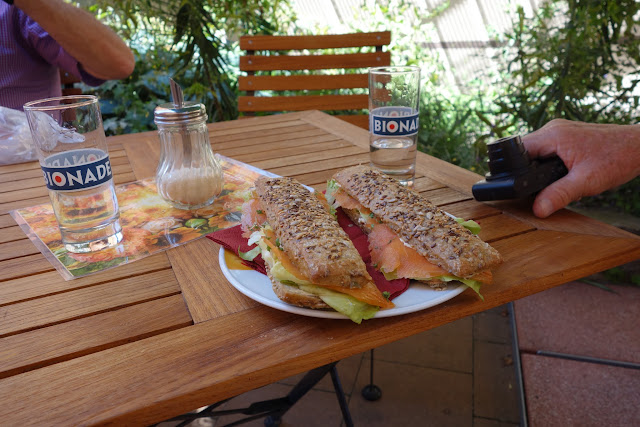6-10 July
Bayreuth (rhyming with My Hoyt) is a very open city with lots of wide streets and squares. Even before war damage the streets seem to have been very open with room for markets. There are several palaces , a ‘Hermitage’ on the hills behind the town, an opera house being refurbished, a free animal park in a lake area where you can find white donkeys, deer and some small kangaroos which look like wallabies but we think their tails are too big. There are other birds and animals. There are also interesting scientific things toppled with in the main street - an Archimedes screw is just one water 'device' - the water course can also be dammed, and there is a small water wheel which allows water to be brought up and emptied. nearby is a very heavy stone. Hard to turn but once it is moving, momentum keeps it going for a long time.
There are also huge gardens attached to the 18th century ‘new palace’ in town. The old palace (17C) is only a few streets away but it hasn’t been restored. Up on the hill the Hermitage (Eremitage, 1715) is a sort of country palace with fountains that play every hour, huge garden and forest areas…and a totally over-the-top ‘new palace’ from the 1750s. We caught buses to see the out-of-town things - a family day pass cost less than two return tickets! The bus driver thought it so amusing that he had sold us family tickets (his initiative) that he came up to us on his way to the back door to tell us with a wide grin that we could take four children with us!
This is Wagner country and there is a Wagner festival every year, a 'Wagner walk' and lots of Wagner references.
Speaking of musicians, there is also a museum in the house where Liszt died. The opera house is a UNESCO heritage site and under restoration for about 4 years at a cost of over €18 million. Visitors are allowed inside for a small fee, to see what is going on and there are exhibitions of the history and on-going restoration.
Our (first) highlight, though, was exploring the ‘catacombs’ under one of the big breweries. Bayreuth is known for having ‘a city under the city’. No-one is entirely sure if they were built deliberately or used for excavating sandstone blocks. They cover almost all the ‘old’ city and are used particularly as cellars for beer, as the temperature is constant - between 7 and 11 degrees. There is a tour which takes a walk through some of these underground passages, taking the opportunity to teach us about beer brewing and some of its history.
In addition, there are displays of how the passages were used during the war bombings. People took shelter there, as their own cellars were too shallow. Various helpers (now heroes) came in with bread, milk, broth and other food, which kept the people alive and in good heart. Parts were used as a hospital and even an operating theatre.
At the end we were all treated to a free glass of beer, which effectively reduced the price of entry, as we all would probably have had a beer about then. There is so much beer drunk here, of all types, varying with region, and drunk by all except children.
Speaking of musicians, there is also a museum in the house where Liszt died. The opera house is a UNESCO heritage site and under restoration for about 4 years at a cost of over €18 million. Visitors are allowed inside for a small fee, to see what is going on and there are exhibitions of the history and on-going restoration.
 |
| Mock-up of the interior of the opera house while it is restored |
 |
| Map of underground passages |
In addition, there are displays of how the passages were used during the war bombings. People took shelter there, as their own cellars were too shallow. Various helpers (now heroes) came in with bread, milk, broth and other food, which kept the people alive and in good heart. Parts were used as a hospital and even an operating theatre.
At the end we were all treated to a free glass of beer, which effectively reduced the price of entry, as we all would probably have had a beer about then. There is so much beer drunk here, of all types, varying with region, and drunk by all except children.
The second highlight: We stayed an extra night, as our host had told us about a performance of Shakespeare’s Midsummer Night’s Dream, put on by the Year 12 students of the local Gymnasium. She was going and thought we might enjoy it. Well, what a performance! Although it was all in German and we didn’t understand much of it, the play was totally alive and the story came across really well. They had updated the costumes to the present - which worked -and had put in a few modern references (e.g. playing golf!). The acting was just superb. Extremely professional. they must have worked hard on it for months. A credit to the hard-work of their teachers and coaches as well. It was such a treat. And we were in the front row, which was pretty special. So glad we stayed.
We used any spare time to talk with our lovely host, Doris, and to catch up on writing and putting together the blog - not a task for the tired! We became adept at finding places with [free] wifi - the library has an hour, the department store, Karstadt, 3 hours, McDonalds 1-2 hours, Deutch Kabel 30 minutes...
Huge thanks to Doris for hosting us and for making such an effort for us.
 |
| In the animal park |
 |
| Not the animal park |



















































